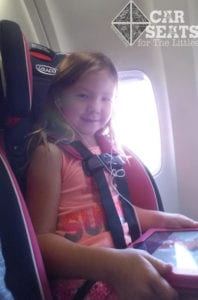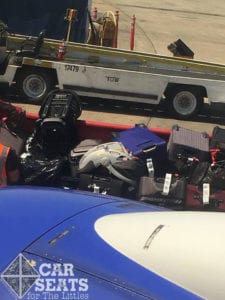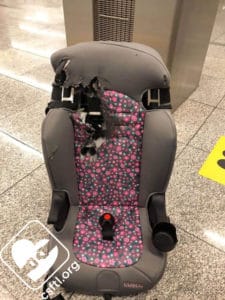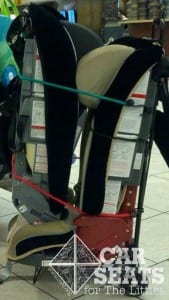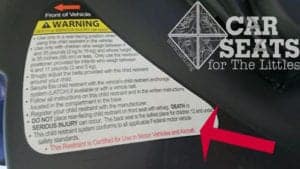Are Car Seats Required on Airplanes?
This article covers many important basics of travel with your Littles. Our second article, On the Road Again takes a closer look at logistics and Terrific Car Seats for Travel shares a few of our favorite travel-friendly car seats.
Traveling with children can be a fun and exciting time. Many parents dread flights they might take with their children because of the long confinement, tight quarters for diaper changes, or unwanted bathroom needs at inconvenient times. The thing that many parents forget to consider is the safety aspect of flying; they assume that since the FAA doesn’t require seats for children under two that their most precious cargo is perfectly safe while flying.
The reality is: they’re not. There’s nothing magical about two years old that makes a child suddenly need a restraint. The FAA recommends that all children use a child restraint on board an aircraft from birth to 40 pounds.
Most parents, when asked, will say that a car seat won’t save their child if the plane drops out of the sky. I will concede that fact; two hundred dollars of plastic and harness will not likely help at the stop of a six-mile vertical drop. However, crashes from cruising altitudes are remarkably rare, thank goodness. Far more likely are runway emergencies or turbulence during flight.
Runway emergencies are just like car crashes, except at 150 mph and not 30 mph. And most parents would pale at the thought of having their child on their laps going to the store at 30 mph, but think nothing of having their child on their lap on the plane at 150 mph.
At 150 mph your child would be your airbag, or they would go flying inside the cabin. A 20 pound child in a 150 mph crash would have 3,000 pounds of force to them. That’s enough to be fatal to themselves, and whomever they impact.
Even if baby is fine after being a projectile, and no one has been injured, if you have ten seconds to get off the plane due to toxic gasses or smoke filling the cabin, you’ll want your baby to be next to you to easily go. An infant can be six rows up and under the seats and easily overlooked during an emergency evacuation. If your child is next to you in a car seat, they’ll still be there after the crash. Remove baby and go.
Babywearing is not a substitute for using a child restraint on board the airplane. Babywearing is not permitted during landing or takeoff, and the carrier is not designed to hold up to the force of a crash. The child will likely be thrown from the carrier or be crushed by the weight of your body, just as if they were sitting on your lap.
Turbulence can happen at any time, and it can be violent enough to throw people into the ceiling or several rows away. While it can be unpredictable, if you are seated you should at least fasten your belt and your children’s harnesses snugly enough so that they do not have to worry about unexpected turbulence, just as the pilot and flight crew suggests.
Remember, on the flight the only things not restrained during taxi, takeoff, and landing are children under two. Children and adults over two, the flight attendants, all carry on baggage, books, computers, soap in the lav, coffee pots, and snacks are secured. But a lap baby is not. For some reason they’re not given the same priority as the peanuts.
In addition to the lack of safety for a child and the people nearby, there is a risk to checking a car seat. If you must check a car seat, put it in its original packaging with padding in the box. Or maybe another box with padding. And then gate check it (it’s far more convenient to use the seat on board than to drag a big box to the gate). All too often I see parents check their car seats at the ticket counter, wrapped in nothing but a plastic bag to keep the cover clean. The cover being clean at the other end is the least of the concerns. The worst thing that can happen is that a car seat arrives at the other end with damage that cannot be seen. A seat that’s been checked as baggage should be looked over very carefully for any damage at all. If there is any concern about the seat at all it should not be used again, but if it looks ok then the manufacturers have said it doesn’t need replacing. All of the manufacturers, however, agree that seats should be used on board for the safety of the child.
The second to worst thing that can happen is that the car seat is lost. Either it didn’t come on your flight with you, or it’s been sent to an alternate destination. Once you check it, it’s baggage, and everyone has either had baggage lost, or knows someone who has. This is fairly common and not something the airline guarantees against. They will get you your bags or money enough to replace what was lost, but when it comes to a car seat, that won’t help in the here and now when you’re picking up your rental car or getting picked up by friends or family. Someone will have to go to the nearest store and buy whatever is in stock to work for the trip.
Sometimes airlines have seats you can borrow, or rental car companies do. These should not be used. You don’t know their history, if they’ve been treated well, cleaned properly, what sorts of messes other children have made in them, what a previous rider may have eaten (especially worrying if you or your child has certain types of allergies). You won’t always know if the seat is recalled or expired. Since this article’s publication date, we’ve scoped out the rental car seats at airports across the country and around the world. Our experience continues to support this caution around using rental car seats.
The third worst thing would be that the seat is obviously broken when you pick it up from baggage claim. That’s what happened to this kind CSFTL family who shared this photo with us. It was pretty clear that this seat must be replaced. That typically means that someone will have to go to a store and buy a new car seat before the kiddo can leave the airport. We suggest that families who aren’t using their car seats on the airplane secure that car seat in a cardboard box when checking it.
Disregarding the safety aspects for both the car seat and the child, there are a lot of advantages to traveling with the car seat that you and your child know. Yes, it’s something extra to bring through the airport and install, but that’s not the bulk of travel, generally. Think about how much easier it will be for you to care for your child by handing them things in their own seat and not balancing them on your lap along with all their toys and snacks (which will inevitably fall on the floor and need to be retrieved) and your own items.
CARES Harness and Ride Safer Travel Vest
Caregivers often ask about the safety of the CARES airplane harness. The problem with the CARES is that it really only fits children on the larger end of its 44 lb weight limit. It does nothing to reposition the lap belt, and smaller toddlers can easily slip right under it. However, its 40 inch height limit means that only a very small number of children will be at a height and weight where it works. It is a viable option for this small subset of children, but only if you will not need to bring a car seat to your destination.
We remain hopeful for FAA approval of the Ride Safer Travel Vest, which will function as an appropriate restraint both on an aircraft and in a vehicle for 3-8 year olds.
Carrying Booster Seats onto Airplanes
Belt positioning booster seats cannot be used on board an aircraft.
If your child regularly rides in a booster seat, our advice is to travel with a backless booster seat. The child can bring it on board as a carry on item, which ensures it will not be lost or damaged. If you would prefer they ride in a high back booster at your destination, you can pack the high back portion of the seat in your luggage, just make sure it is well packed to avoid any damage. Other great backless booster seat options to consider for travel are the Chicco GoFit, the Cosco Rise, and the BubbleBum.
Official Regulations and Guidelines
If you’re looking for the “official” word on this subject, here are just a few resources:
From the FAA: FAA Child Safety
“The safest place for your child under the age of two on a U.S. airplane is in approved child restraint system (CRS) or device, not in your lap. Your arms aren’t capable of holding your in-lap child securely, especially during unexpected turbulence, which is the number one cause of pediatric injuries on an airplane.
The FAA strongly urges you to secure your child in an approved CRS or other approved device for the entirety of your flight. Buying a ticket for your child is the only way to guarantee that you will be able to use a CRS. It’s the smart and right thing to do so that everyone in your family arrives safely at your destination.”
From the AAP: AMERICAN ACADEMY OF PEDIATRICS Restraint Use on Aircraft
“Occupant protection policies for children younger than 2 years on aircraft are inconsistent with all other national policies on safe transportation. Children younger than 2 years are not required to be restrained or secured on aircraft during takeoff, landing, and conditions of turbulence. They are permitted to be held on the lap of an adult. Preventable injuries and deaths have occurred in children younger than 2 years who were unrestrained in aircraft during survivable crashes and conditions of turbulence. The American Academy of Pediatrics recommends a mandatory federal requirement for restraint use for children on aircraft.”
From the NTSB: Child Passenger Safety on Aircraft
“Chairman Hersman stated, “We appreciate the FAAC acknowledging the dangers associated with children flying on their parents’ laps, but we would have preferred to see the FAA be mandated to require that every person including our youngest children be restrained appropriately for their age and size.” She continued, “We know that the safest place for children younger than age two traveling on airplanes is in an appropriate child safety seat. The era of the lap child on airplanes should come to an end.””
Note for Canadian Families
According to Transport Canada, when children are less than 2 years old, they need to have a 1:1 ratio with accompanying adults. It’s considered an evacuation risk. This regulation applies whether the children have tickets and are riding in a car seat or being held on their caregivers’ laps. The regulation is 1 child under 2 per adult.
Travel Tips
Because now that you know your baby needs a seat, we have a whole slew of tips to help with the logistics of getting everyone from the terminal to their seats and back again:
For even more aiport/airplane travel pictures, check out our album of air travel fan photos!
Use a stroller and stack the car seats on it, then babywear the child or have the child walk next to you.
Or, attach the car seat to the stroller and have the child ride in the stroller. This doesn’t work for every stroller but when it does work, it’s a great option!
- Use a travel cart for car seats. Examples: GoGo Kidz Travelmate, BRICA Roll & Go Car Seat Transporter, Britax Car Seat Travel Cart.
- Use a luggage cart with bungee cords (can work for multiple seats at once)
- Use a Traveling Toddler to attach your car seat to your rolling suit case.
- Baby wear
- Use a stroller
- If the child still fits in a rear facing only car seat, use the car seat and stroller or frame and gate check the stroller
- Have older children walk
- Let the child sit in the car seat on the GoGo Kidz/luggage cart/Traveling Toddler
- Let the child sit on the suitcase itself
- Diapers/portable potty. Bring about a diaper an hour, or a potty with a removable and disposable liner.
- Snacks for children eating solids, bottles and formula if you need
- A few small favorite games and toys and books
- A few new small games or toys or books (don’t forget to bring new for the return trip)
- A change of clothes and a clean shirt for you
- Any lovey/comfort item
- Spare pacis if they’re used
- An empty sippy cup for an older child (have the flight attendant fill it during the drink rounds so you don’t need to deal with it at security)
- Offer to buy a drink for anyone around you who seems annoyed by a child. Especially if their rear facing seat is in the way of reclining. “I’m sorry my child’s safety seat is in the way. Can I offer to buy you a drink for your inconvenience?”
- If you have a tall forward facing car seat that does not allow the tray to be used, put a pillow on the child’s lap for meals/drawing. It works better than you might think.
- Some forward facing car seats can benefit from a seatbelt extender for ease of uninstallation. A rear facing Diono Radian can also benefit from a seatbelt extender (you’ll also want your angle adjuster!). Ask for one as you get on board from the flight attendant but keep in mind that not all flight attendants are willing to hand them out for this purpose.
- American airline carriers are required to abide by the FAA regulations. Nearly all convertibles and infant seats are FAA approved to their weight limits rear and forward facing. However, internationally, carriers are not required to follow the FAA regulations. Check your airline’s rules before you fly, and ideally before you purchase so you are not surprised on the plane.
- Carry a copy of the FAA regulations with you, in case there’s a flight attendant who is not aware of the car seat rules. The Advisory Circular can be found here.
- Familiarize yourself with the location of the FAA approval stickers on your car seats before you travel. Usually, it’s red lettering in a sticker that has a lot of black text on it as well. Almost all car seats with a 5 point harness are FAA approved and will have a sticker stating as such. Current exceptions are the Graco SmartSeat, Combi Zeus, and Safety 1st/IMMI Go Hybrid.
- Remember that even long trips are a few hours or a day of your life and your child’s life. If they scream and are That Baby for the entire flight, you’ve annoyed a few people for a few hours. You have not permanently scarred anyone for life, and it will be over soon.
- Try booking your flight, or at least checking airfares, in the middle of the night. Fares are often (not always) cheaper.
- Consider flying in and out of neighboring airports. For example, a flight for a family of four from Seattle to Albany, NY costs $2400. By flying to NYC the total is $1100. Then drive three hours.
Learn More
A summary of the FAA regulations – 9/27/15. This updates the previous version of 11007.pdf.Take a closer look at the logistics of navigating the airport, boarding the airplane, and traveling solo with your Littles in our sequel to this post, On The Road Again — Another Look at Travel with Littles

